Betty & George Woodman: domestic ceramic from Italy to Charleston
In a new exhibition at Charleston, the former home of Vanessa Bell & Duncan Grant, art of another duo, Betty & George Woodman, sheds light on ceramics, the domestic & the history of arts.
Jelena Sofronijevic visited the Sussex house to discover the Woodman’s work & its connection to their own house outside Florence.
When the American
ceramicist Betty Woodman started working with clay in the 1950s, she began with
functional, domestic objects. But she became increasingly experimental with age,
producing installations which smashed the boundaries between sculpture, architecture,
and the visual arts.
Woodman’s 2006 exhibition at the Metropolitan Museum of Art in New York City was the museum’s first of a living woman artist, and its first solo exhibition for a living potter. Beyond the US, she has been shown in Amsterdam’s Stedelijk Museum, and in a recent group exhibition at London’s Hayward Gallery. But Charleston’s Betty Woodman and George Woodman, housed in the hills of East Sussex, is the first to curate her in conversation with George Woodman, a painter and her partner.
Without context, we might assume that George (as a man) was better known, that this co-curation is a bid to bring Betty’s work to light. But that’s not the case; her name comes first, and his works often provide the context for hers. It’s the best kind of exhibition, one that leaves out enough to make you read more once you leave.
![]()
![]()
Though they shared an “aesthetic attitude to life,” and influenced each others’ practices, the two artists scarcely worked in collaboration: rightly, they’re never referred to as The Woodmans. The Etruscan Vases (1965-1966), thrown by Betty and painted by George, are the only collaborative works shown, fittingly captioned with details of their joint, but individually motivated, moves between America and Italy.
Academic postings – and privilege – permitted them to move more permanently from Colorado in 1968. With their children, they spent every summer in their Antella farmhouse on the outskirts of Florence, visiting museums, galleries, and churches. Art was the religion of the secular family. Their influences became more global, from the geometric patterns of Cosmatic floor mosaics, to tile walls in Moorish Spain, Portugal, Turkey, Morocco, and Mexico.
![]()
![]()
Betty had previously experimented with Etruscan pottery; but from here, she became increasingly bold in challenging conventions. In the 1970s, she combined Roman pots and Chinese porcelain pillows to produce her unique Pillow Pitchers, which gained more colour and glaze as she grew with confidence. By the turn of the century, clay became paint in her hands. In her Wallpaper (2017) series, ceramic offcuts are slashed against the wall, part-Italian fresco, and part-Jackson Pollock.
![]()
![]()
Italy inspired Betty’s architectural turn. Here, she ‘inverted’ architectural traditions, using ceramics as architecture, rather than the decoration or ornament of architecture. In The Kitchen Table (2014), she takes this to its logical conclusion, drawing Roman frescos, where paintings of columns create an “illusion … of architecture within architecture.” Her inclusion of ceramic vases challenges the marginalisation of the craft, suggesting the medium’s architectural and sculptural qualities.
![]()
![]()
Her late works – inspired by travels in Asia – are thrilling. Her His/Hers Vases draw as much from Japanese prints as European modern art in subject matter, challenging the exotification of women’s bodies in European abstract and post-Impressionist visual artworks. For Betty, the art was neither in the individual sculptures, nor their pairing, but the negative space between them; perhaps emphasising the difference between her and her partner.
Exploring both artists’ works in conversation brings new connections to light. More subtly, it shines a light on how she (as a woman) nurtured his career, pushing him to be more boundary-pushing too. In this final room, we see George’s experiments with folding screens, turning flat painting into folding architectures similarly inspired by Japan. In his photographs are Chinese prints from the Metropolitan Museum of Modern Art – the same institution to show Betty’s work. Whilst he experimented with the medium in the 1980s, it wasn’t until the 2000s that his works become more layered – influenced by his photographer daughter, Francesca Woodman.
![]()
![]()
George was also experimental, moving between tessellating paintings to paper tile installations. But if where Betty exploded the boundaries between ceramics and architecture, George quietly drew from it; many of his paintings feature classical sculptures of women’s bodies, the sort which typically adorned Italian churches, perhaps a comment on the social position of women as ornaments too.
Betty pushed George to realise his paper designs in ceramic form. From his ‘first commission’ - the family bathroom in Antella - he would produce a number of permanent public projects in the US throughout the 1980s. It’s a subtle nod to the role of women as facilitators in the art history of men.
Betty Woodman and George Woodman gives us the sense that both artists saw each other as equals. Though Betty turned from functional pottery towards sculpture in the 1980s, her works remain rooted in the home. Whilst her Aragosta Soup Tureen (1980) is transformed beyond function; domestically useless, it becomes a work. But she still glazes it the same blue colour of George’s studio windows and sills in New York, his furniture in Colorado, and his studio door in Antella.
![]()
![]()
Nor did Betty reinforce a non-/domestic binary. She saw cooking as a creative, pleasurable act; preparing food fuelled her and her husband’s creativity - something shared with the South African potter Hylton Nel, whose plates fill the gallery opposite. Making and using her works was equally important. Being a good cook made her a better artist.
Betty and George Woodman is perhaps also curated in conversation with Charleston itself. The two artists share much in common with the former residents of this farmhouse, Vanessa Bell and Duncan Grant, who also often created for each other. Their home, decorative, but lived in, embodies the notion of art as life, with ceramics used in daily life.
![]()
![]()
Nevertheless, in reading the artists in their own words, we get a sense of what Betty and Vanessa Bell share in common too. Both women appropriated domestic objects - also marginalised, and relegated to the private sphere – and transformed them into art. But perhaps the concept of appropriation is somewhat anachronistic, an extensive projection of their progressive views on gender. Yet for both, their work and practices disrupted the artificial distinctions between arts and crafts, between art and life.
But whilst the Woodman children saw the studio as an “extension of their house,” they also appreciated the seriousness of art; and grew up “terrified to break a pot.” With its focus on Antella, the exhibition offers little visual archive material; the 2010 documentary The Woodmans provides an eye-opening alternative to the narrative presented here with the Woodman Family Foundation Archive. From this, we get a sense of how the artists constructed their own realities too – architects of their own status in art history.
![]()
Woodman’s 2006 exhibition at the Metropolitan Museum of Art in New York City was the museum’s first of a living woman artist, and its first solo exhibition for a living potter. Beyond the US, she has been shown in Amsterdam’s Stedelijk Museum, and in a recent group exhibition at London’s Hayward Gallery. But Charleston’s Betty Woodman and George Woodman, housed in the hills of East Sussex, is the first to curate her in conversation with George Woodman, a painter and her partner.
Without context, we might assume that George (as a man) was better known, that this co-curation is a bid to bring Betty’s work to light. But that’s not the case; her name comes first, and his works often provide the context for hers. It’s the best kind of exhibition, one that leaves out enough to make you read more once you leave.

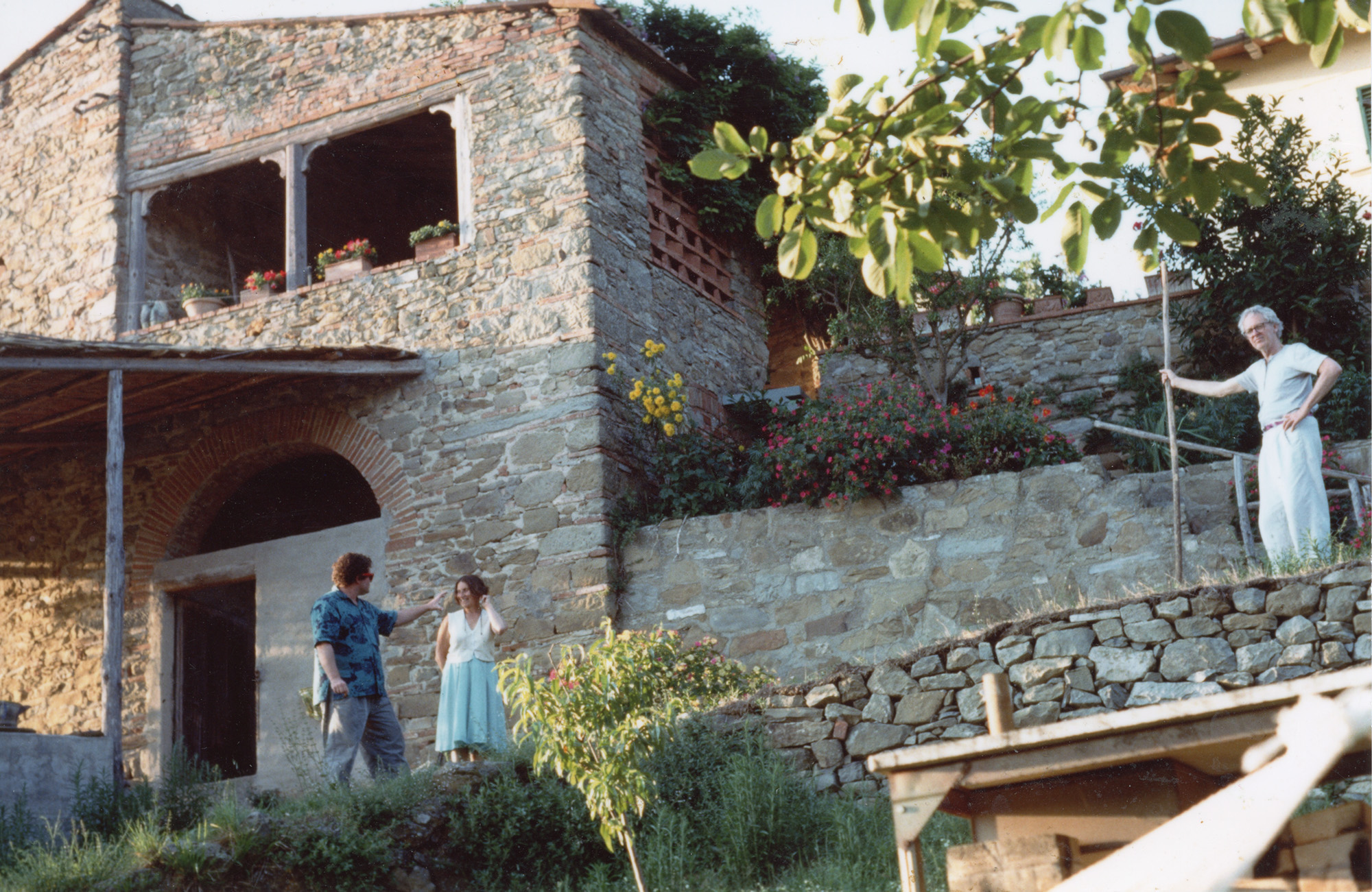
Figs.i,ii
Though they shared an “aesthetic attitude to life,” and influenced each others’ practices, the two artists scarcely worked in collaboration: rightly, they’re never referred to as The Woodmans. The Etruscan Vases (1965-1966), thrown by Betty and painted by George, are the only collaborative works shown, fittingly captioned with details of their joint, but individually motivated, moves between America and Italy.
Academic postings – and privilege – permitted them to move more permanently from Colorado in 1968. With their children, they spent every summer in their Antella farmhouse on the outskirts of Florence, visiting museums, galleries, and churches. Art was the religion of the secular family. Their influences became more global, from the geometric patterns of Cosmatic floor mosaics, to tile walls in Moorish Spain, Portugal, Turkey, Morocco, and Mexico.
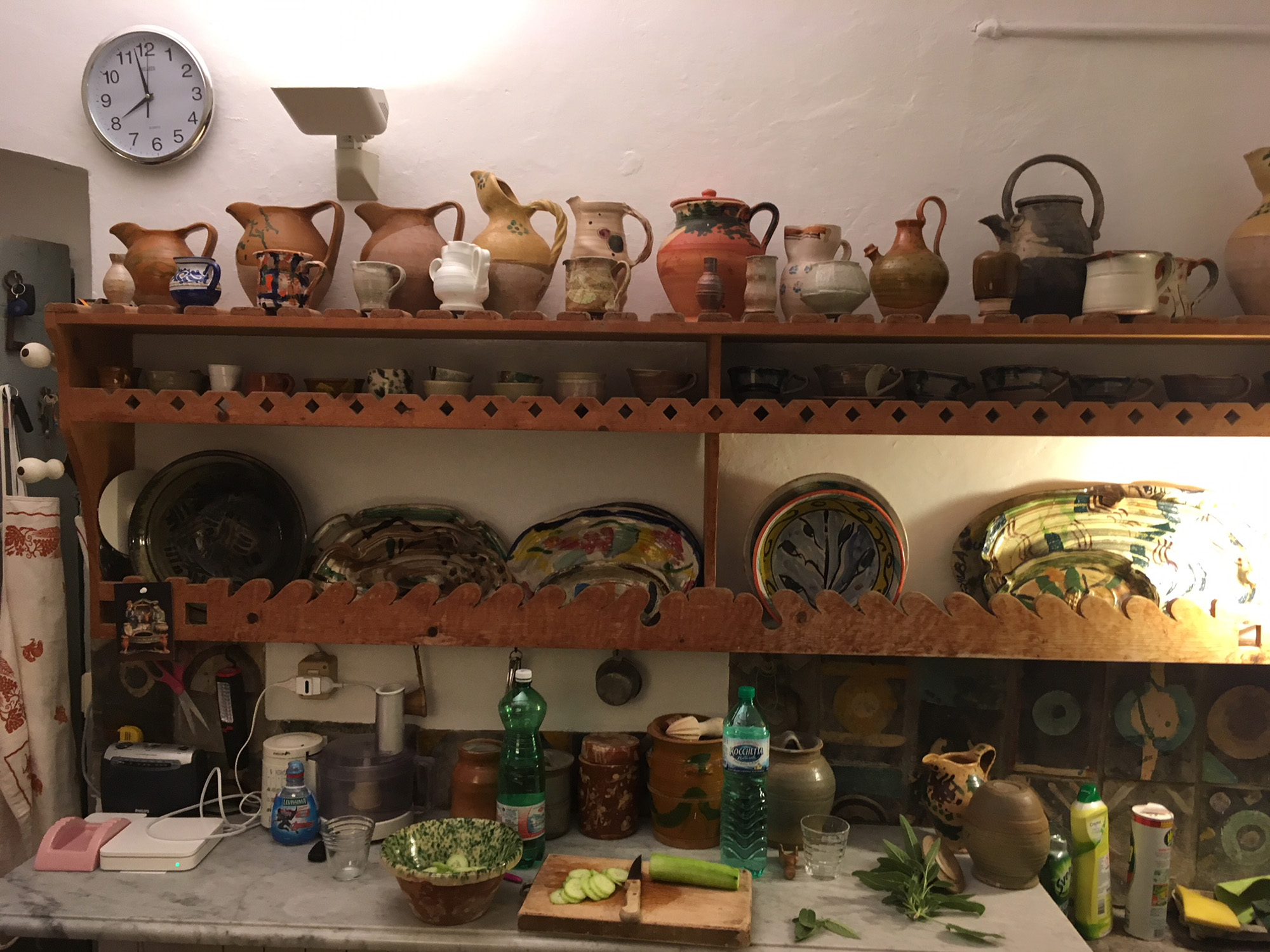
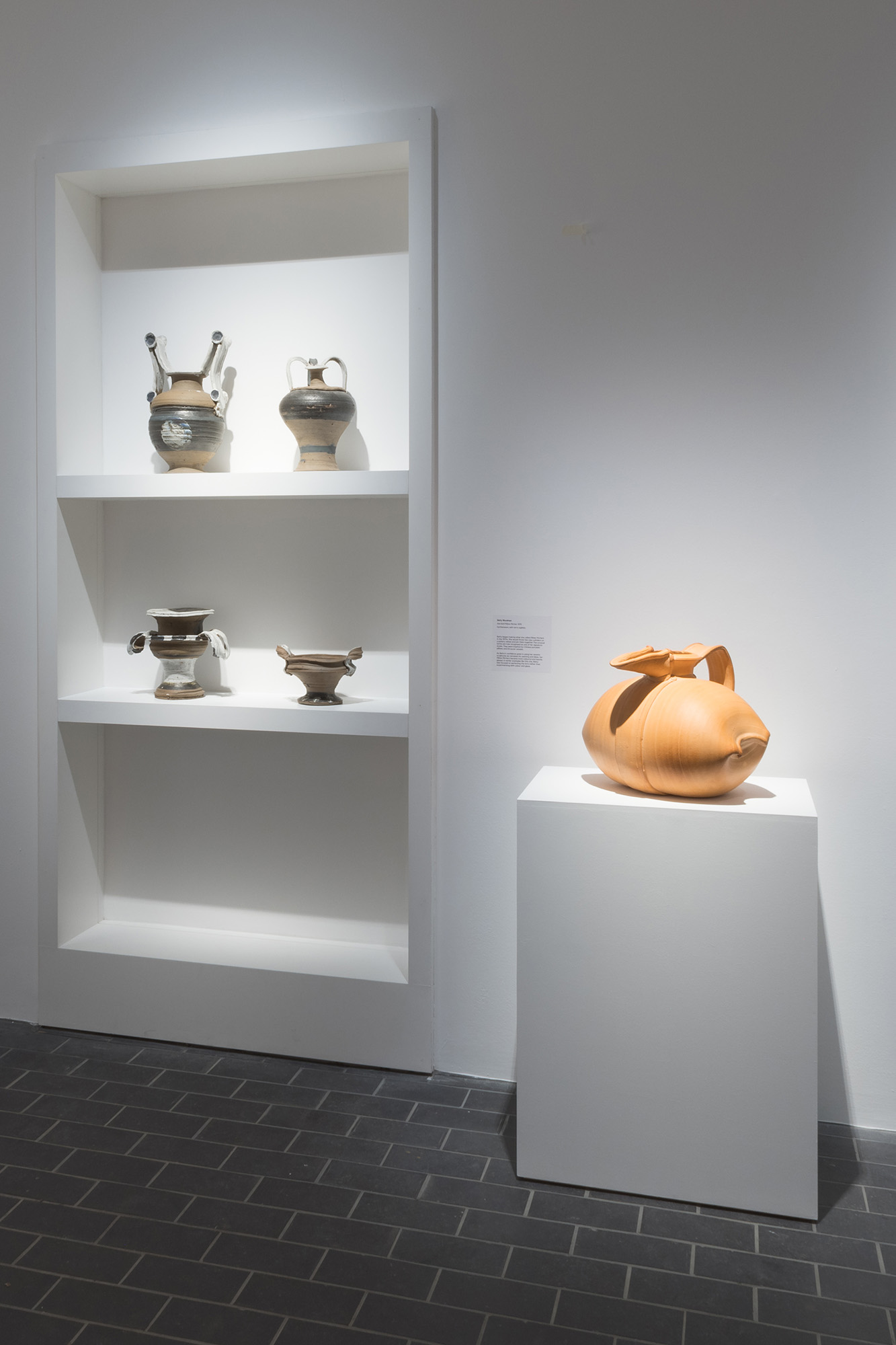
Figs.iii,iv
Betty had previously experimented with Etruscan pottery; but from here, she became increasingly bold in challenging conventions. In the 1970s, she combined Roman pots and Chinese porcelain pillows to produce her unique Pillow Pitchers, which gained more colour and glaze as she grew with confidence. By the turn of the century, clay became paint in her hands. In her Wallpaper (2017) series, ceramic offcuts are slashed against the wall, part-Italian fresco, and part-Jackson Pollock.

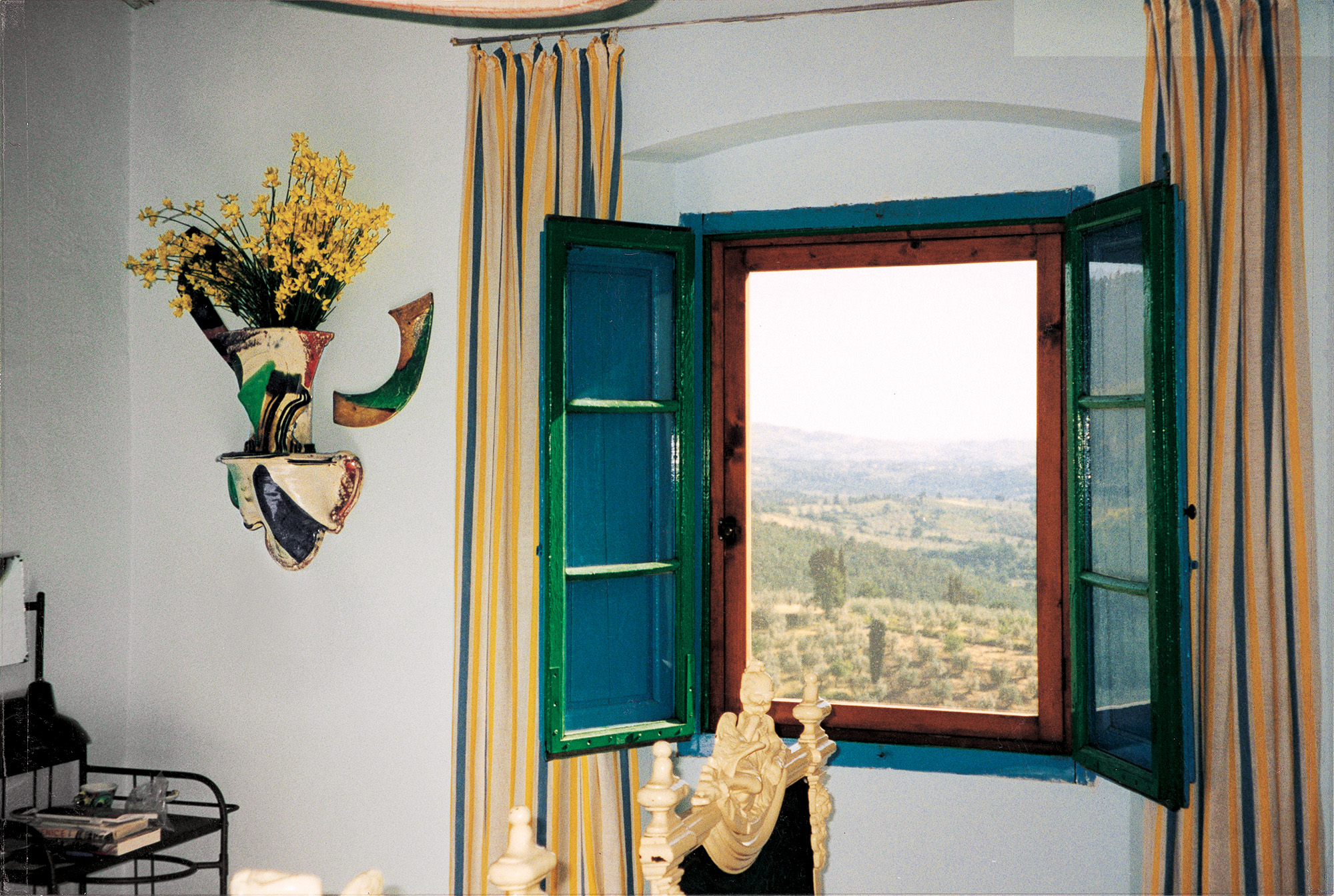
Figs.v,vi
Italy inspired Betty’s architectural turn. Here, she ‘inverted’ architectural traditions, using ceramics as architecture, rather than the decoration or ornament of architecture. In The Kitchen Table (2014), she takes this to its logical conclusion, drawing Roman frescos, where paintings of columns create an “illusion … of architecture within architecture.” Her inclusion of ceramic vases challenges the marginalisation of the craft, suggesting the medium’s architectural and sculptural qualities.
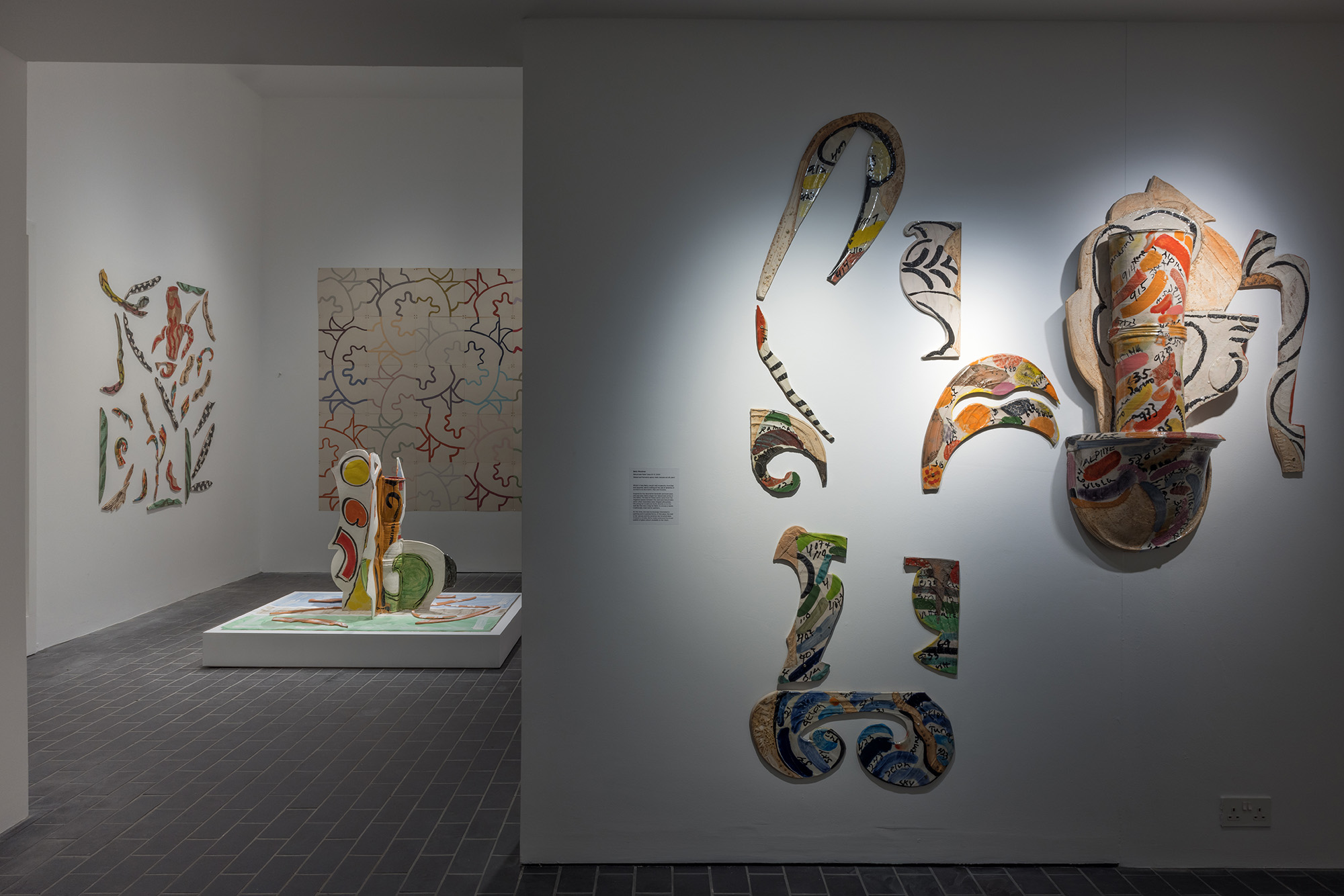

Figs.vii,viii
Her late works – inspired by travels in Asia – are thrilling. Her His/Hers Vases draw as much from Japanese prints as European modern art in subject matter, challenging the exotification of women’s bodies in European abstract and post-Impressionist visual artworks. For Betty, the art was neither in the individual sculptures, nor their pairing, but the negative space between them; perhaps emphasising the difference between her and her partner.
Exploring both artists’ works in conversation brings new connections to light. More subtly, it shines a light on how she (as a woman) nurtured his career, pushing him to be more boundary-pushing too. In this final room, we see George’s experiments with folding screens, turning flat painting into folding architectures similarly inspired by Japan. In his photographs are Chinese prints from the Metropolitan Museum of Modern Art – the same institution to show Betty’s work. Whilst he experimented with the medium in the 1980s, it wasn’t until the 2000s that his works become more layered – influenced by his photographer daughter, Francesca Woodman.
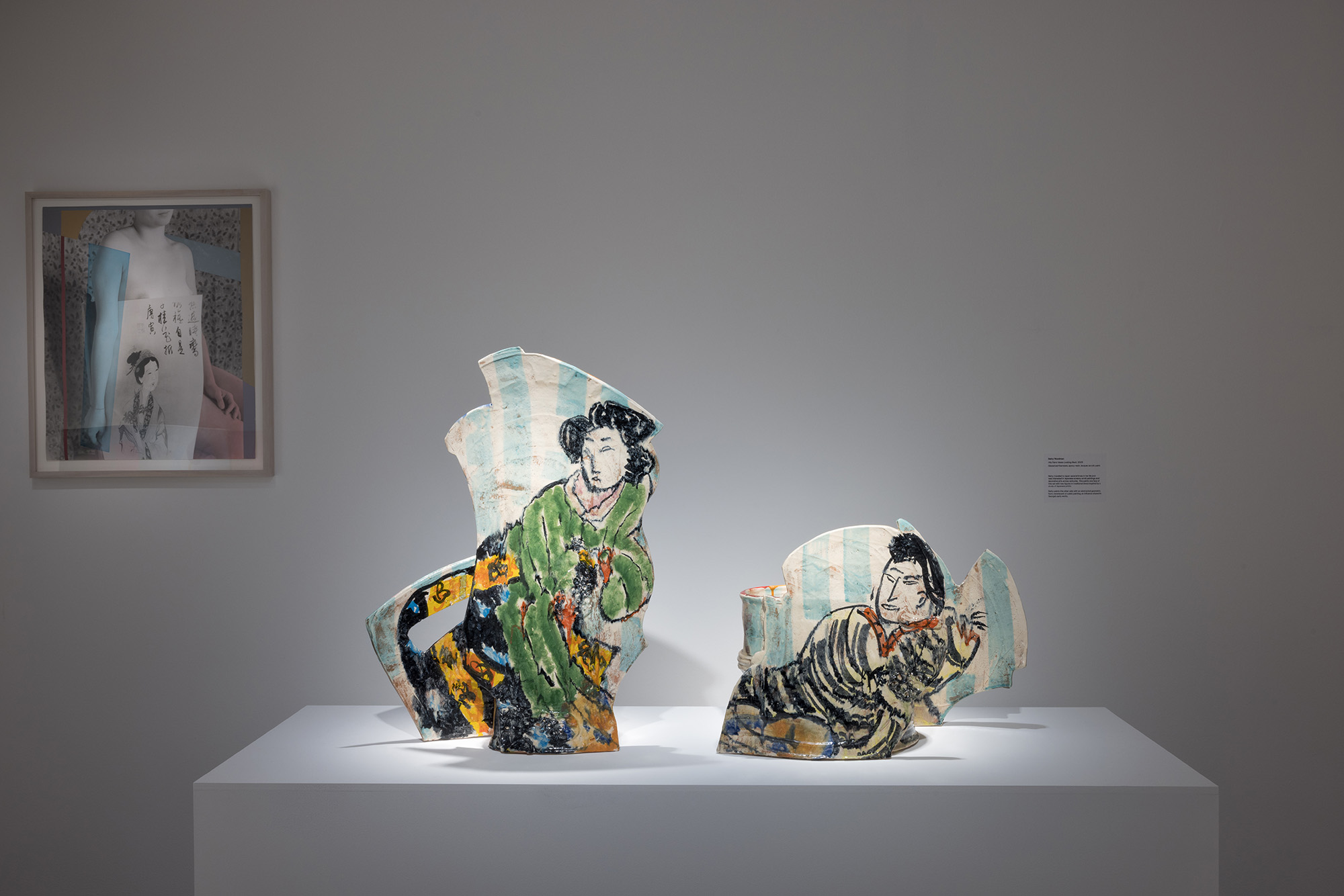

Figs.ix,x
George was also experimental, moving between tessellating paintings to paper tile installations. But if where Betty exploded the boundaries between ceramics and architecture, George quietly drew from it; many of his paintings feature classical sculptures of women’s bodies, the sort which typically adorned Italian churches, perhaps a comment on the social position of women as ornaments too.
Betty pushed George to realise his paper designs in ceramic form. From his ‘first commission’ - the family bathroom in Antella - he would produce a number of permanent public projects in the US throughout the 1980s. It’s a subtle nod to the role of women as facilitators in the art history of men.
Betty Woodman and George Woodman gives us the sense that both artists saw each other as equals. Though Betty turned from functional pottery towards sculpture in the 1980s, her works remain rooted in the home. Whilst her Aragosta Soup Tureen (1980) is transformed beyond function; domestically useless, it becomes a work. But she still glazes it the same blue colour of George’s studio windows and sills in New York, his furniture in Colorado, and his studio door in Antella.
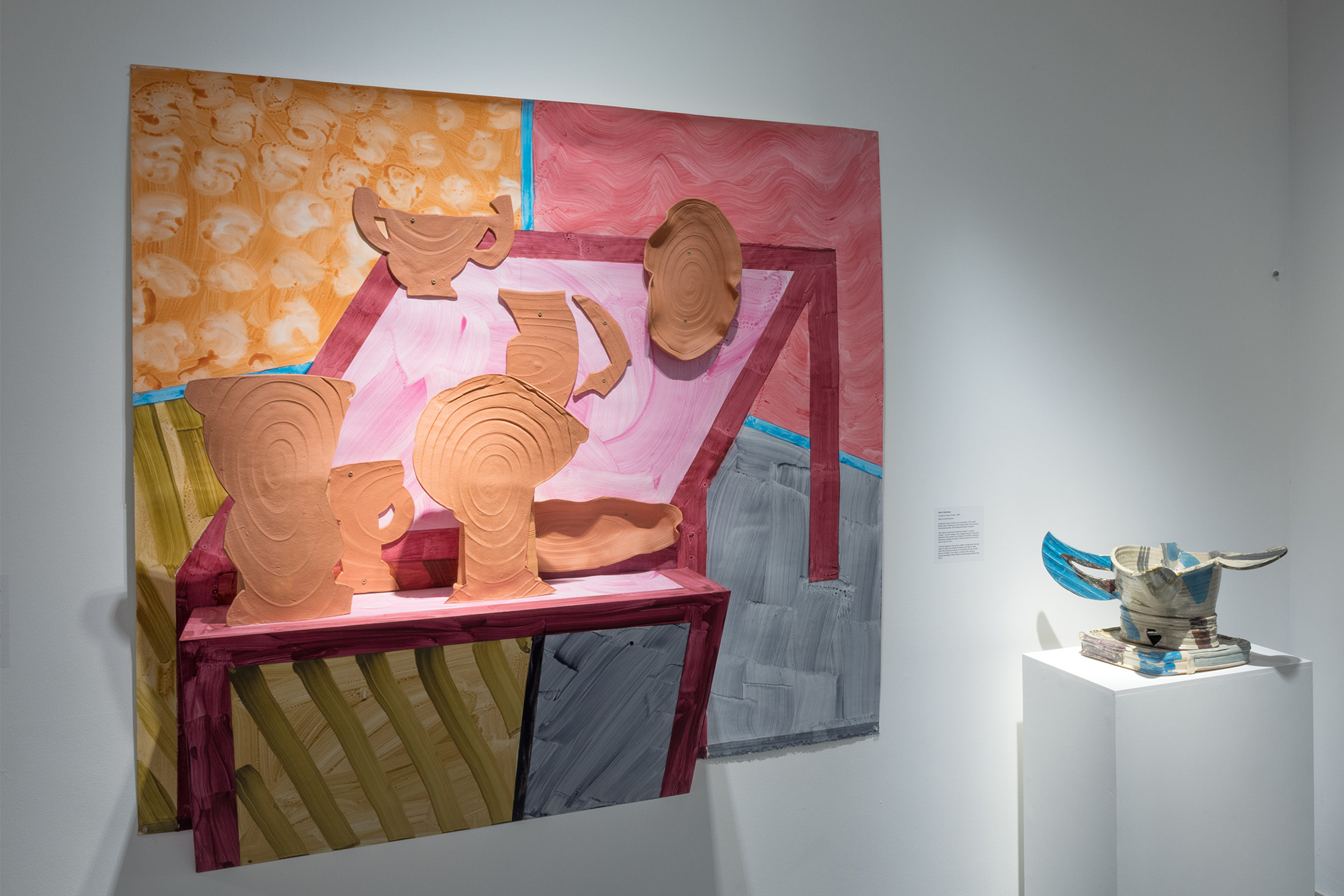

Figs.xi,xii
Nor did Betty reinforce a non-/domestic binary. She saw cooking as a creative, pleasurable act; preparing food fuelled her and her husband’s creativity - something shared with the South African potter Hylton Nel, whose plates fill the gallery opposite. Making and using her works was equally important. Being a good cook made her a better artist.
Betty and George Woodman is perhaps also curated in conversation with Charleston itself. The two artists share much in common with the former residents of this farmhouse, Vanessa Bell and Duncan Grant, who also often created for each other. Their home, decorative, but lived in, embodies the notion of art as life, with ceramics used in daily life.

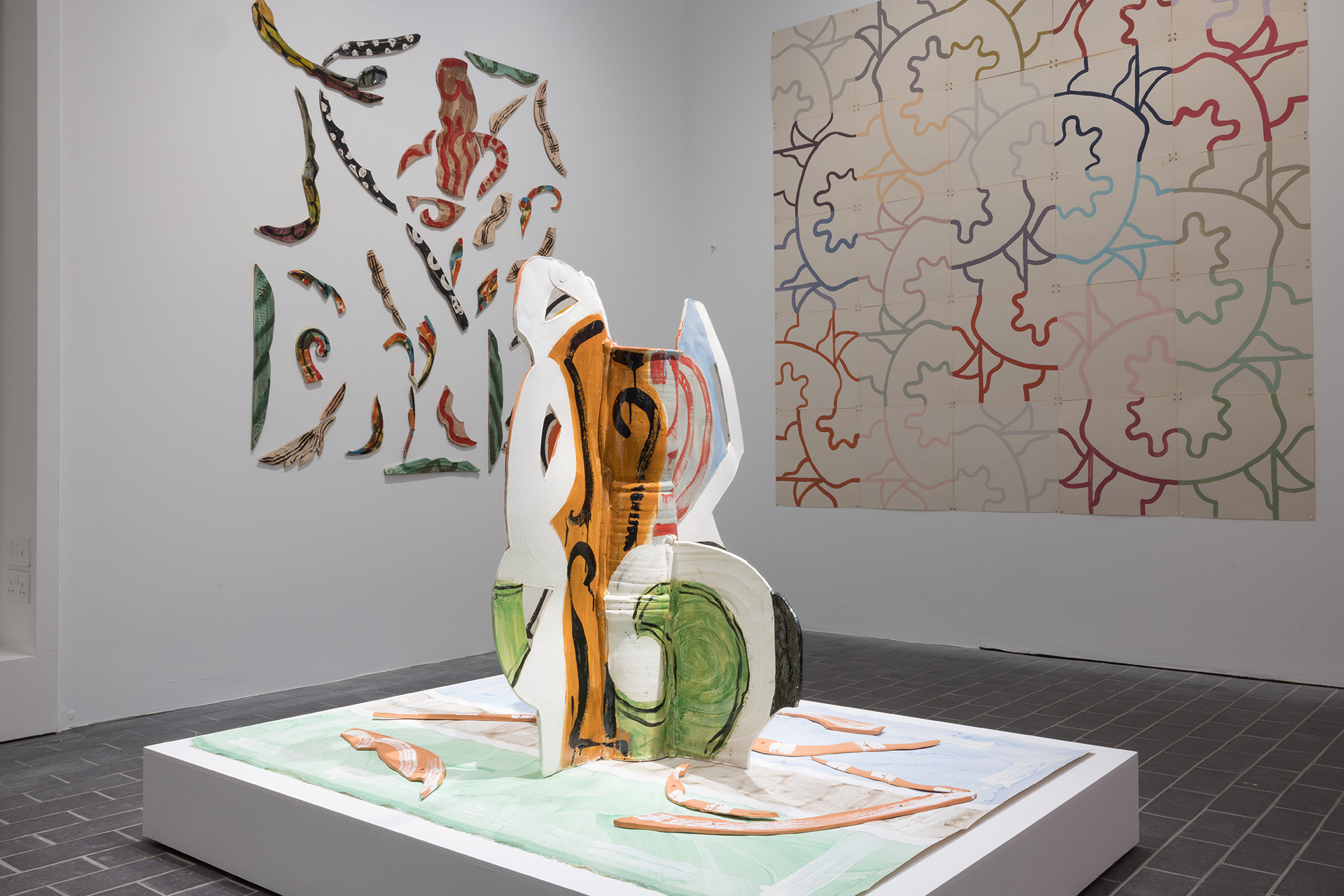
Figs.xiii,xiv
Nevertheless, in reading the artists in their own words, we get a sense of what Betty and Vanessa Bell share in common too. Both women appropriated domestic objects - also marginalised, and relegated to the private sphere – and transformed them into art. But perhaps the concept of appropriation is somewhat anachronistic, an extensive projection of their progressive views on gender. Yet for both, their work and practices disrupted the artificial distinctions between arts and crafts, between art and life.
But whilst the Woodman children saw the studio as an “extension of their house,” they also appreciated the seriousness of art; and grew up “terrified to break a pot.” With its focus on Antella, the exhibition offers little visual archive material; the 2010 documentary The Woodmans provides an eye-opening alternative to the narrative presented here with the Woodman Family Foundation Archive. From this, we get a sense of how the artists constructed their own realities too – architects of their own status in art history.
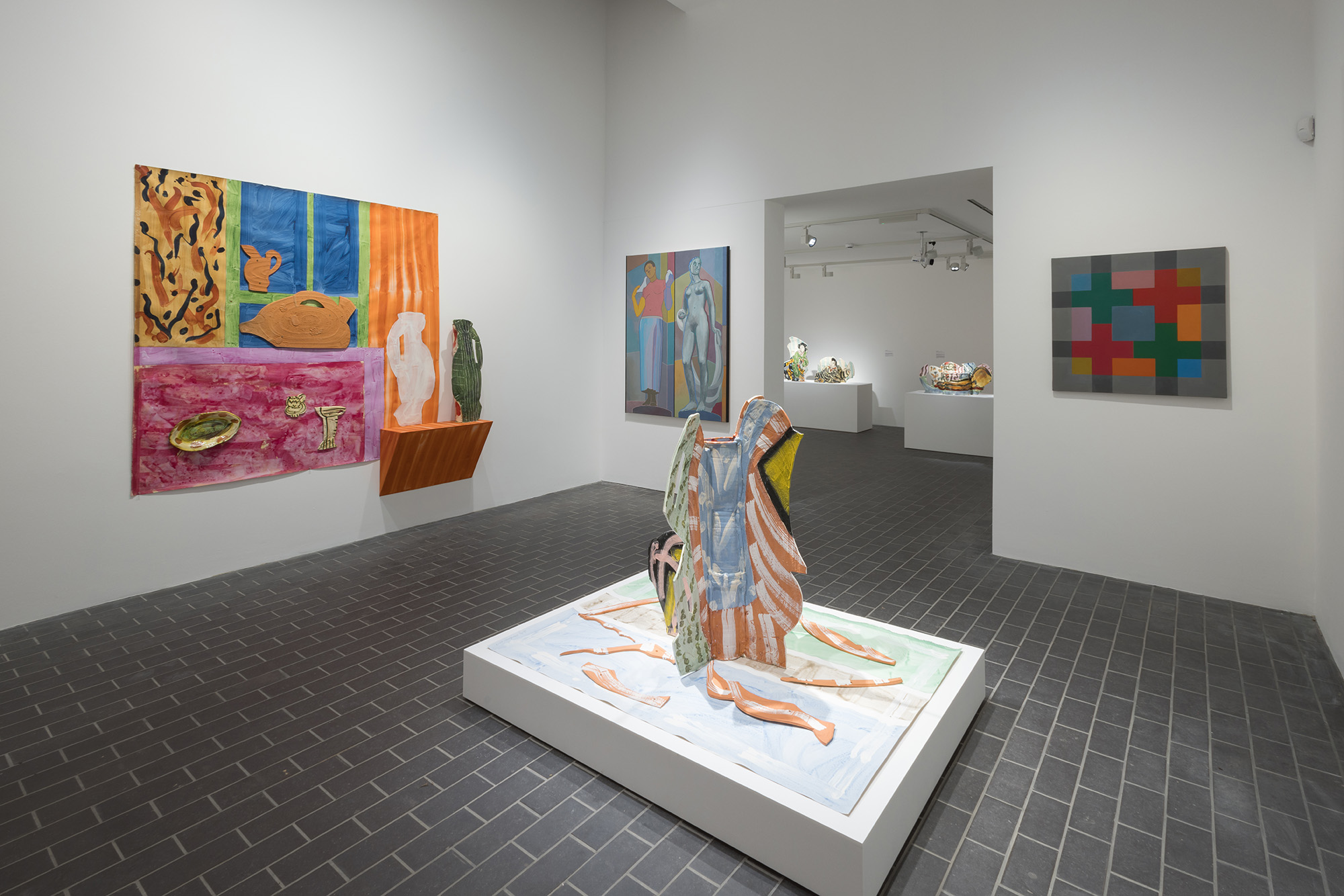
Figs.xv
Jelena Sofronijevic is an audio producer & freelance journalist who creates content at the intersections of cultural and
political history. They are the producer of EMPIRE LINES, a podcast which
uncovers the unexpected flows of empires through art, and historicity, a new
series of audio walking tours, exploring how cities got to be the way they are.
www.jelsofron.com
EMPIRE LINES
historicity
visit
Betty Woodman and George Woodman is exhibited at Charleston, Sussex, until 10 September 2023. More information at:
www.charleston.org.uk/exhibition/betty-woodman-and-george-woodman
images
fig.i Betty Woodman, Night Window (2016).
Courtesy of Woodman Family Foundation. © Woodman Family Foundation, DACS,
London.
fig.ii Outside at Antella. Woodman Family
Foundation Archive.
fig.iii Kitchen at Antella. Woodman Family
Foundation Archive.
figs.iv,v,vii,x,xi,xiii,xiv Installation images, Betty Woodman and George Woodman at Charleston (2023) © The Charleston Trust; photograph: James Bellorini.
fig.vi View from Antella. Woodman Family
Foundation Archive.
fig.viii Betty Woodman at Antella c 1970s. Woodman Family Foundation Archive.
fig.ix Betty Woodman George Woodman Antella Italy C 1973 Woodman Family Foundation
Archive.
fig.xii George Woodman, Still Life With Chair (2000). Courtesy of Woodman Family Foundation. ©Woodman Family Foundation, DACS,
London.
fig.xiii George Woodman, Bathroom Tiles, Antella. Woodman Family Foundation Archive.
publication date
05 May 2003
tags
Antella, Asia, Vanessa Bell, Body, Charleston, Ceramics, Domestic, Florence, Frescos, Furniture, Geometry, Duncan Grant, Italy, Metropolitan Museum of Modern Art, Pottery, Sculpture, USA, Betty Woodman, Francesca Woodman, George Woodman
www.charleston.org.uk/exhibition/betty-woodman-and-george-woodman


